- Status: Critically endangered
- Known as: Hawksbill Sea Turtle, Caret, tortue caret
- Estimated numbers left in wild: Approximately 15,000 females capable of laying eggs.
Description of the Hawksbill Sea Turtle
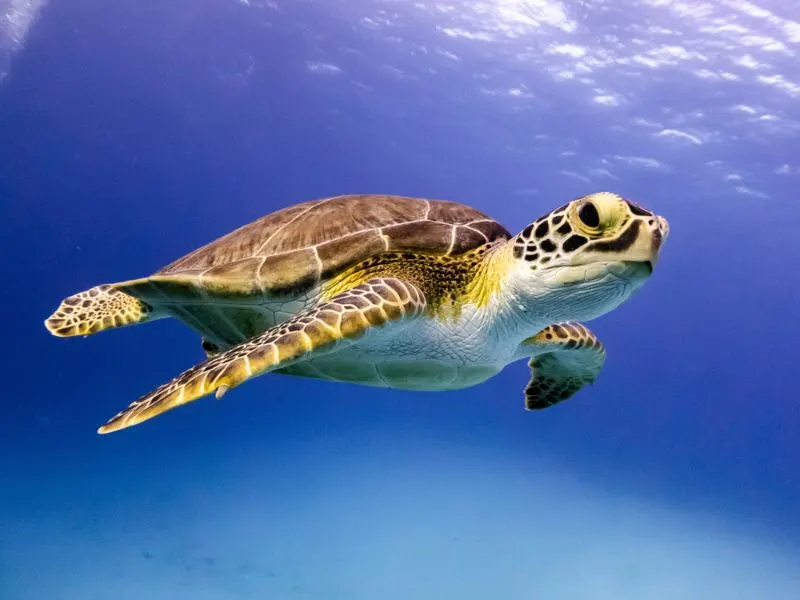
The Hawksbill sea turtle is a medium-sized turtle that lives in a wide band across the tropical and subtropical oceans of the world. Seldom reaching more than 115 centimeters in length and 75 kilograms, these turtles spend nearly their entire lives in the ocean, with the females only coming ashore to lay their eggs.
The hawksbill turtle has a slender head that ends in a definite ‘beak,’ giving the animal its name. The head and limbs have black scales on a pale yellow background, and the carapace (upper shell) is composed of overlapping plates that are mottled amber, brown, and gold.
Hawksbill sea turtles prefer to live in shallow coastal waters, especially near reefs and lagoons where food is abundant. These turtles love to eat sponges but also fish, crustaceans, algae, jellyfish, and mollusks.
The adult turtles will never venture much lower than about 20 meters below the surface, and the young remain very close to the surface, known as their aquatic phase.
As the turtles mature, they begin to access deeper waters around reefs. Unlike the mass nesting behavior of many sea turtles, female hawksbill turtles will nest alone or only in small groups.
The female comes ashore at night (even clambering over rocks or other obstacles), clears a suitable area of vegetation, digs a hole in the sand with her back flippers, and lays about 140 eggs.
In about 60 days, the eggs will hatch at night, and the hatchlings will scramble toward the ocean, directed by the reflected light of the moon and stars on the water.
It has been found that the flesh and eggs of hawksbill sea turtles contain chlorotoxin. Researchers are uncertain how the turtles collect this toxin but might ingest it with their food.
People who eat the flesh or eggs of turtles containing this toxin will suffer from a variety of unpleasant symptoms: vomiting, nausea, chest pain, dizzy spells, swollen tongue, sore throat, multiple organ failure, coma, and death.
Children are more likely to become ill than adults, and the toxin can pass through breast milk. The skin of this turtle can also contain chlorotoxin.
Location
Hawksbill sea turtles are found along tropical and subtropical coastlines around the globe. These turtles prefer shallow water, especially around coral reefs, lagoons, atolls, and oceanic islands.
They also tend to use waters where sandy beaches are available for nesting.
Behavior
They are known to mate underwater. The hawksbill sea turtles are also known for having the most genetically diverse sex chromosomes out of all vertebrate species and have a very good sense of smell. They typically only come to shore when they need to lay eggs and usually only do so every 2-6 years.
They are very territorial and will fight to defend their territory. Hawksbill sea turtles are typically very fast swimmers, allowing them to keep up with large schools of fish they target for food.
Habitat
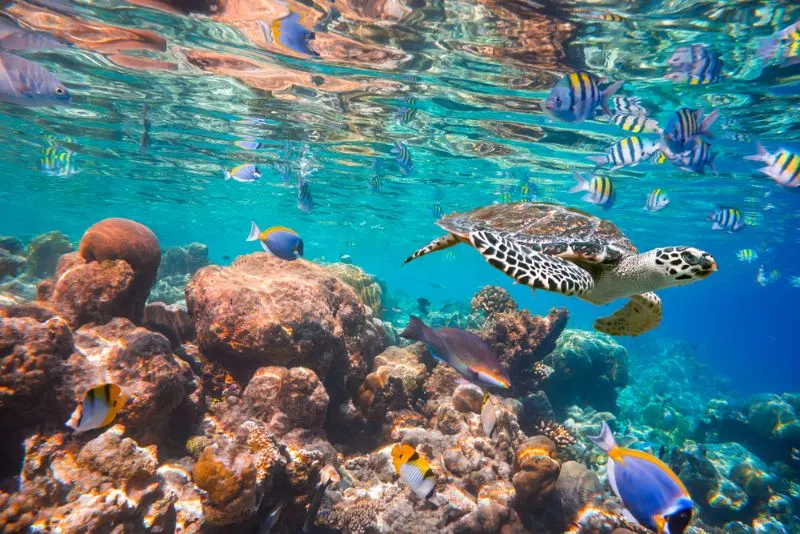
The hawksbill sea turtles typically only come to shore when they need to lay eggs and usually only do so every 2-6 years to reproduce. They usually live in coral reefs but can also be found in turtle grass meadows.
They are found in the Atlantic Ocean, Pacific Ocean, and the Indian Ocean. They are typically found in tropical climates but have been seen in sub-tropical environments.
Facts About the Hawksbill Sea Turtle
A hawksbill sea turtle is a type of sea turtle that lives in shallow, tropical marine waters. These turtles are known for their thick and solid shell. The hawksbill sea turtle possesses a single subspecies that is found in the Indo-Pacific region near hawksbill reefs which can be found as far east as Australia and New Zealand, east to the Marshall Islands, and west to Western Africa.
The hawksbill’s lifespan is unknown because they are hard to find in the wild due to population decline due to human harvesting of hawksbill eggs.
Hawksbill Sea Turtle Conservation
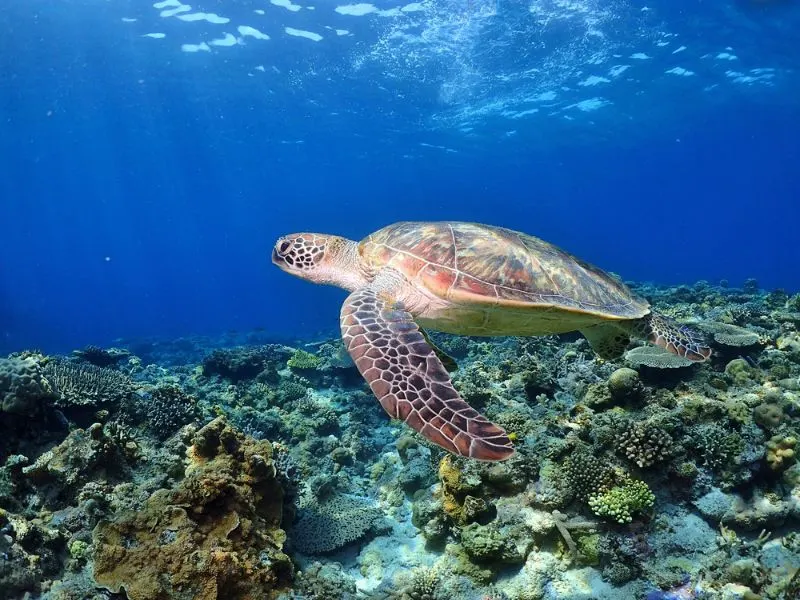
The hawksbill sea turtles experience many threats, such as bycatch, habitat destruction and fragmentation, climate change, and marine pollution. Hawksbill sea turtles are typically found in coral reefs, and they provide a great way to monitor the ecosystem’s health.
Global hawksbill sea turtle populations are rapidly declining due to hawksbill sea turtle conservation efforts that have been implemented by many countries worldwide, such as Costa Rica.
Bycatch is one of the hawksbill sea turtles’ main sources of mortality. Bycatch “is the incidental capture of animals by humans during activities such as fishing, shipping, and recreational boating.”
Because hawksbill sea turtles spend a lot of time in areas that are dense with fish and other marine life they are very susceptible to being caught up in nets that fishermen use to catch fish. In the hawksbill sea turtle’s lifespan, they will be captured on average once and sometimes up to four times.
Poachers who hunt for hawksbill sea turtle eggs often frequent beaches, leaving the turtle’s eggs vulnerable to theft and exploitation.
Threats to the Hawksbill Sea Turtle
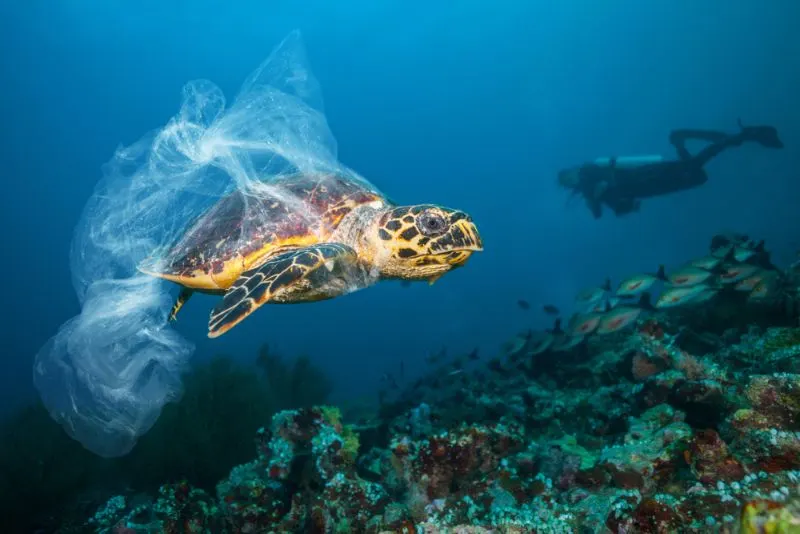
Although the hawksbill sea turtle does have a few natural enemies such as killer whales and crocodiles, the greatest threat to the continued existence of the turtle is man. Hunted almost to extinction for its shell, made into tortoiseshell items, the hawksbill is now granted worldwide protection.
Legal trade in its shell has been prohibited, but poaching still causes many yearly turtle deaths. Continued use of turtles as a food source and the ingestion of their eggs reduces the population, although poisonings are also a significant problem in parts of Southeast Asia. Destructive development near marine habitats is dangerous for all hawksbill turtles.
See Related: Impactful Ways to Conserve Coral Reefs
Organizations
Oceana

Oceana is the largest international organization focused only on ocean conservation, protecting marine ecosystems, and protecting endangered species such as the hawksbill sea turtle.
Sea Turtle Conservancy
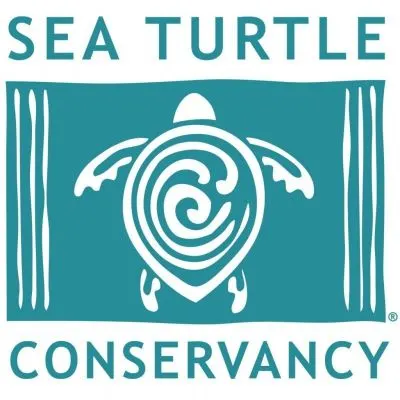
Sea Turtle Conservancy works to protect the 7 different remaining sea turtle species found in the oceans and their habitats through research, education, training and advocacy.
Wildlife Conservation Society

Wildlife Conservation Society was formed in 1895 to protect 25 percent of the world’s biodiversity by promoting the importance of protecting wildlife and their habitats. WCS has five zoos in New York.
See Related: Conservation vs Preservation
Frequently Asked Questions (FAQ)
Why is the Hawksbill Sea Turtle Endangered?
The hawksbill sea turtle is threatened because, like other marine turtles, it spends much time on beaches cleared for humans. The natural home for the hawksbill turtle is the forest edge over sandy beaches – but now, these only exist in small numbers. When hawksbill turtles swim out to feed in shallow waters, they are vulnerable to being caught by fishermen, hooked on lines or nets, or harmed by pollution.
There are hawksbill turtles in Australian waters but not enough information about their numbers. From April to October each year around Queensland’s Sunshine Coast (and from March to May around the New South Wales east coast), hawksbills gather in the ocean to feed on turtles’ favorite food: sponges.
Where Does the Hawksbill Sea Turtle Live?
The hawksbill sea turtle usually lives in the tropical waters of the Atlantic, Pacific, and Indian Oceans. The hawksbill is found in temperate seas primarily in three areas: off the coast of West Africa, along much of Central America’s Caribbean coast, and parts of Panama’s Pacific coast.
The hawksbill spends less time than other turtles at sea because it prefers coastal environments where they can find plenty to eat as well as a safe place to dig nests for laying eggs that protect from predators.
What Does the Hawksbill Sea Turtle Look Like?
The hawksbill sea turtle is typically brownish or purplish on its carapace and has a pattern of overlapping scales that form three to seven short longitudinal lines.
It also has a narrow, tapered snout with two sharp projections near the end, large eyes, and an oval-shaped shell. Finally, it’s one of the smaller species of sea turtles, which isn’t surprising considering they’re primarily found in coral reefs. However, there are some hawksbill populations around temperate ocean waters, such as off the West coast of Africa south from Senegal through Angola and westward to Ghana.
The hawksbill’s diet consists mainly of sponges but also includes mollusks such as octopus, urchins, and seaweed. Key hawksbill sea turtle habitat areas include coral reefs, mangrove swamps, and seagrass beds in warm tropical waters. However, some hawksbill populations have been recorded inhabiting rocky shores and sandy beaches.
What Is Being Done to Save the Hawksbill Sea Turtle?
Some hawksbill turtles are being used in tourism because of their unusual appearance.
Local operators on the Indonesian island Komodo often supplement their income by catching hawksbills and selling them to foreign tourists.
The hawksbill turtle has been overhunted for the pet trade, even though they don’t live long in captivity. They are also killed for their shells and eggs in parts of the region that still rely on traditional medicine, where hawksbill carapaces (shells) are boiled down, dried, or roasted to make a powder believed to ease pain and bring good health.
The hawksbill turtle has been critically endangered on the IUCN Red List since 1996. It is illegal to catch or kill hawksbill turtles in many of their habitats worldwide, but they are still being poached at an alarming rate. Many conservation efforts have started to help improve the numbers of hawksbill turtles.
In 2006, the United States Fish and Wildlife Service listed hawksbill turtles as threatened under the Endangered Species Act. This law greatly helps conservation efforts by prohibiting hawksbill imports to the U.S. for all commercial and non-commercial purposes unless permits are obtained from the government. It also makes it illegal to harm hawksbill turtles in any way or take them from their natural habitats.
This law does not protect hawksbill turtles living outside the U.S., but many other organizations are working to save hawksbill sea turtle populations.
The Turtle Conservancy, a non-profit group based in Maryland, has joined forces with the government in Costa Rica to protect hawksbills nesting along this country’s coast. The conservation efforts in Costa Rica were successful in the first year, and many nests were recorded.
On July 1, 2007, more than 300 hawksbill turtle eggs hatched on that one beach alone. This is a great success because hawksbill turtles don’t lay many eggs at one time. Historically, hawksbills were often seen nesting on just a few beaches with poor protection from predators.
